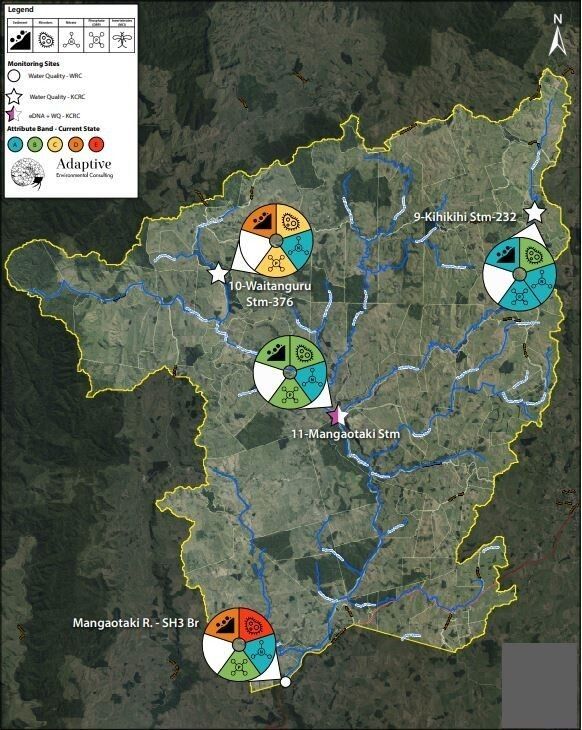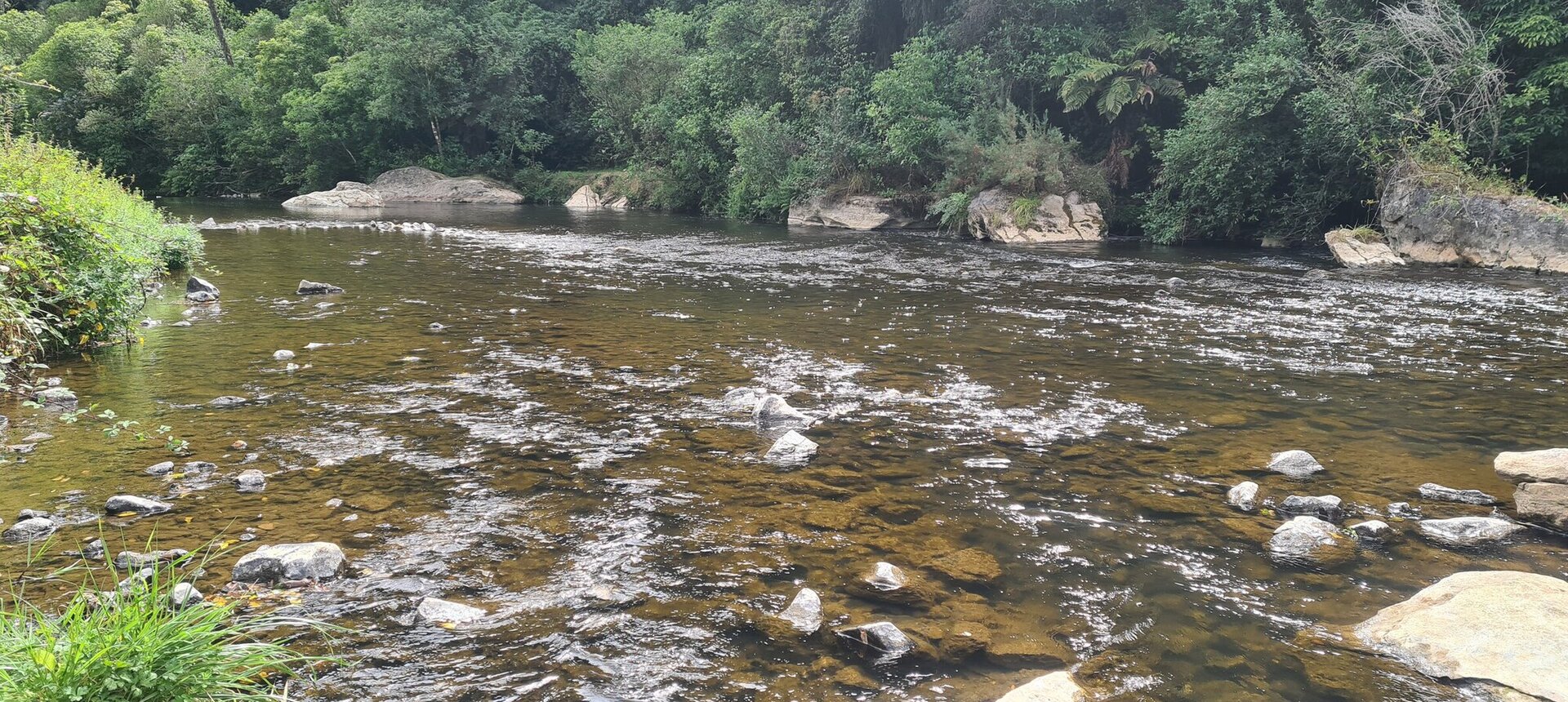2025 Quarterly Results
August 2025
Water quality was Fair in Waitanguru stream (Site 10) and Mangaotaki river (Site 11), and Poor in Kihikihi stream (Site 30).
E. coli concentrations were slightly elevated in all sites, though all sites fell within health guidelines for swimming (540 cells per 100 mL).
Nitrogen:
Nitrate concentrations were slightly elevated across sites (0.79 – 1.01 mg/L) but fell well below ecological toxicity levels (2.4 mg/L). Ammonia concentrations were very low across all sites (< 0.005 mg/L).
Dissolved inorganic nitrogen (DIN) was slightly elevated across in Waitanguru stream and Mangaotaki river (0.79 – 1 mg/L) and elevated in Kihikihi stream (1.01 mg/L), exceeding the ecological impact threshold (0.5 mg/L).Phosphorus: Dissolved reactive phosphorus (DRP) concentrations were low in Mangaotaki river and Kihikihi stream (0.009 mg/L) and slightly elevated in Waitanguru stream (0.012 mg/L).
Suspended sediment/Water Clarity: Water clarity was Fair in Waitanguru stream (1.48 m) and Poor in Mangaotaki river (1.26 m) and Kihikihi stream (0.96 m), relative to the national bottom line (1.34 m).
The results in the table below have been graded according to the National Policy Statement for Freshwater Management (NPS-FM, 2020).
Sample Collection Day: 25th August 2025

Mokau River – Summary of water quality collected from 15 sites across the Mokau River catchment on 25th August 2025
Water quality was Fair across the Mokau River Catchment. While most sites had low to moderate levels of E. coli and phosphorus, 80% of all sites had poor water clarity and exceeded the ecological threshold for dissolved inorganic nitrogen.
E. coli (Microbial Contamination):
Most sites (73%) had low concentrations (≤ 240 cells per 100 mL), a low risk for swimming.
Three sites (20%) had very low concentrations (< 100), considered safe for livestock drinking water[1].
Four sites (27%) had slightly elevated concentrations (280 - 460 cells per 100 mL).Nitrogen
Nitrate:
Three sites (20%) had low concentrations (≤ 0.5 mg/L).
Twelve sites (80%) exceeded ecological impact thresholds (0.5 mg/L), which can affect stream health.
All sites fell well below ecological toxicity thresholds (2.4 mg/L) for native fish and invertebrates.Ammonia:
Most sites had low concentrations (<0.005 - 0.03 mg/L), of little concern for aquatic life.
One site (Huioteko stream) had slightly elevated concentrations (0.15 mg/L), which can impact sensitive aquatic species.Dissolved Inorganic Nitrogen (DIN):
Three sites (20%) had low concentrations (≤ 0.50 mg/L).
10 sites (67%) were slightly elevated (0.51 – 1.0 mg/L), exceeding the ecological impact threshold of (0.5 mg/L).
Two sites (13%) had concentrations exceeding 1 mg/L, which is of particular concern for aquatic life.Phosphorus
Dissolved Reactive Phosphorus (DRP):
Most sites (93%) had low levels (<0.002 - 0.009 mg/L).
One site (Waitanguru) was slightly elevated (0.012 mg/L), which can contribute to problematic plant and algae growth if levels stay high.Suspended Sediment / Water Clarity:
Three sites (20%) had Excellent water clarity (A band).
One site (Waitanguru stream) had Fair water clarity (C band).
Nearly three quarters of all sites (73%) had Poor water clarity (D band).
Water clarity bands for each site are based on the National Bottom Line (NBL), which varies depending on local landscape characteristics (e.g. geology, climate, and elevation). For Mokau River sites, the NBL is either 1.34 m or 0.61 m, depending on location.
[1] Drinking water for livestock should contain < 100 cfu/100 mL (median value) of E. coli. Livestock Drinking Water Guidelines (2023), Australian & New Zealand Guidelines for Fresh & Marine Water Quality.
May 2025
Water quality was Fair in Waitanguru stream (Site 10) and Mangaotaki river (Site 11) and Poor in Kihikihi stream (Site 30).
E. coli concentrations were low in Waitanguru stream and slightly elevated in Mangaotaki river and Kihikihi stream. All sites fell within health guidelines for swimming (540 cells per 100 mL).
Nitrogen:
Nitrate concentrations were moderate across sites (0.63 - 0.80 mg/L), falling well below ecological toxicity levels (2.4 mg/L). Mangaotaki river had the lowest concentration and Waitanguru stream had the highest concentration.
Ammonia concentrations were very low across all sites (< 0.005 mg/L).
Dissolved inorganic nitrogen (DIN) was slightly elevated across all sites, above the ecological impact threshold (0.5 mg/L).Phosphorus:
Dissolved reactive phosphorus (DRP) concentrations were slightly elevated at all sites (0.011 - 0.014 mg/L).Suspended sediment/Water Clarity: Water clarity was Good in Waitanguru stream (1.56 m), Fair in Mangaotaki river (1.48 m) and Poor in Kihikihi stream (1.28 m), relative to the national bottom line (1.34 m).
The results in the table below have been graded according to the National Policy Statement for Freshwater Management (NPS-FM, 2020).
Collection date: 15th May 2024

Mokau River – Summary of water quality collected from 15 sites across the Mokau River catchment on 15th May 2025
Water quality was Fair across the Mokau River Catchment. While most sites had low to moderate levels of E. coli, nitrogen, and phosphorus, and water clarity was good at over half the locations, a few sites exceeded ecological thresholds for nutrients and water clarity.
E. coli (Microbial Contamination):
Most sites (60%) had low concentrations (≤ 230 cells per 100 mL) low risk for swimming.
Two sites (13%) had very low concentrations (< 100), considered safe for livestock drinking water[1].
A third of sites (33%) had slightly elevated concentrations (370 - 490 cells per 100 mL).
One site (Puputaha stream) had high levels (690 cells per 100 mL) which could pose a health risk, especially when swimming.Nitrogen
Nitrate:
All 15 sites had low to moderate concentrations (0.06 - 0.80 mg/L), falling well below ecological toxicity thresholds (2.4 mg/L) for native fish and invertebrates.
However, 4 sites exceeded ecological impact thresholds (0.5 mg/L), which can affect stream health.
Ammonia:
All sites had very low concentrations (<0.005 - 0.08 mg/L), little concern for aquatic life.
Dissolved Inorganic Nitrogen (DIN):
Most sites (73%) had low concentrations (≤ 0.46 mg/L).
Four sites (27%) were slightly elevated (0.63 - 0.80 mg/L), exceeding the ecological impact threshold of (0.5 mg/L).Phosphorus
Dissolved Reactive Phosphorus (DRP):
Two-thirds of sites (67%) had low levels (<0.002 - 0.009 mg/L).
Five sites (33%) were slightly elevated (0.011 – 0.014 mg/L) which can contribute to problematic plant and algae growth if levels stay high.Suspended Sediment / Water Clarity:
Over half of sites (53%) had Good water clarity (A or B band).
Two sites (13%) had Fair water clarity (C band).
A third of sites (33%) had Poor water clarity (D band).
Water clarity bands for each site are based on the National Bottom Line (NBL), which varies depending on local landscape characteristics (e.g. geology, climate, and elevation). For Mokau River sites, the NBL is either 1.34 m or 0.61 m, depending on location.
[1] Drinking water for livestock should contain < 100 cfu/100 mL (median value) of E. coli. Livestock Drinking Water Guidelines (2023), Australian & New Zealand Guidelines for Fresh & Marine Water Quality.
February 2025
Water quality was Fair across in Waitanguru stream (Site 10) and Kihikihi stream (Site 30) and Poor in Mangaotaki river (Site 11).
E. coli concentrations were very high across all sites (range = 1,300 to 1,400 cells per 100 mL), exceeding recommended health guidelines for swimming (540 cells per 100 mL).
Nitrogen:
Nitrate concentrations were low to moderate across sites (range = 0.45 to 0.56 mg/L), falling well below ecological toxicity levels (2.4 mg/L). Kihikihi stream had the lowest concentration and Mangaotaki river had the highest concentration.
Ammonia concentrations were low across all sites (≤ 0.02 mg/L).
Dissolved inorganic nitrogen (DIN) was low in Waitanguru stream and Kihikihi stream (≤ 0.5 mg/L), falling just below the ecological impact threshold (0.5 mg/L). Mangaotaki river had slightly elevated DIN (0.58 mg/L).Phosphorus:
Dissolved reactive phosphorus (DRP) concentrations were low in Mangaotaki stream and Kihikihi stream (≤ 0.009 mg/L). Waitanguru stream had slightly elevated DRP (0.011 mg/L).Suspended sediment/Water Clarity: Water clarity was excellent in Waitanguru stream (3.35 m), good in Kihikihi stream (1.73 m) and poor in Mangaotaki river (1.21 m), relative to the national bottom line (1.34 m).
The results in the table below have been graded according to the National Policy Statement for Freshwater Management (NPS-FM, 2020).
Collection date: 18th February 2025

Mokau River – Summary of water quality collected from 15 sites across the Mokau River catchment on 18th February 2025
Most sites had low nutrient levels, but elevated E. coli and poor water clarity were common, with a few locations exceeding human health and ecological health thresholds.
E. coli: 60% of sites had elevated concentrations (between 890 and 3,100 cells per 100 mL), 20% (3 sites) had slightly elevated concentrations (between 300 and 500), and 20% had low concentrations (≤ 170).
Nitrogen:
Nitrate: 100% of sites had low concentrations (range = 0.001 to 0.56 mg/L). Ammonia: 100% of sites were low to moderate (range = <0.005 to 0.200 mg/L). Dissolved Inorganic Nitrogen (DIN): 93% of sites had low concentrations (≤ 0.50 mg/L), and 7% (1 site) was slightly elevated (0.58 mg/L), exceeding the ecological impact threshold of 0.5 mg/L.Phosphorus:
Dissolved Reactive Phosphorus (DRP): 80% of sites had low concentrations (between <0.002 and 0.009 mg/L), 13% (2 sites) were slightly elevated (0.011 – 0.012 mg/L), and 7% (1 site) returned a very high concentration (0.024 mg/L).Suspended Sediment / Water Clarity: 47% of sites had good water clarity (A or B band), 7% (1 site) had fair water clarity (C band), and the remaining 47% had poor water clarity (D band). Bands for each site relate to the National Bottom Line (NBL) for water clarity and depend on landscape characteristics including geology, climate, and elevation. The NBL for Mokau River monitoring sites is either 1.34 m or 0.61 m, depending on local landscape characteristics.
Water Quality Summary 2024
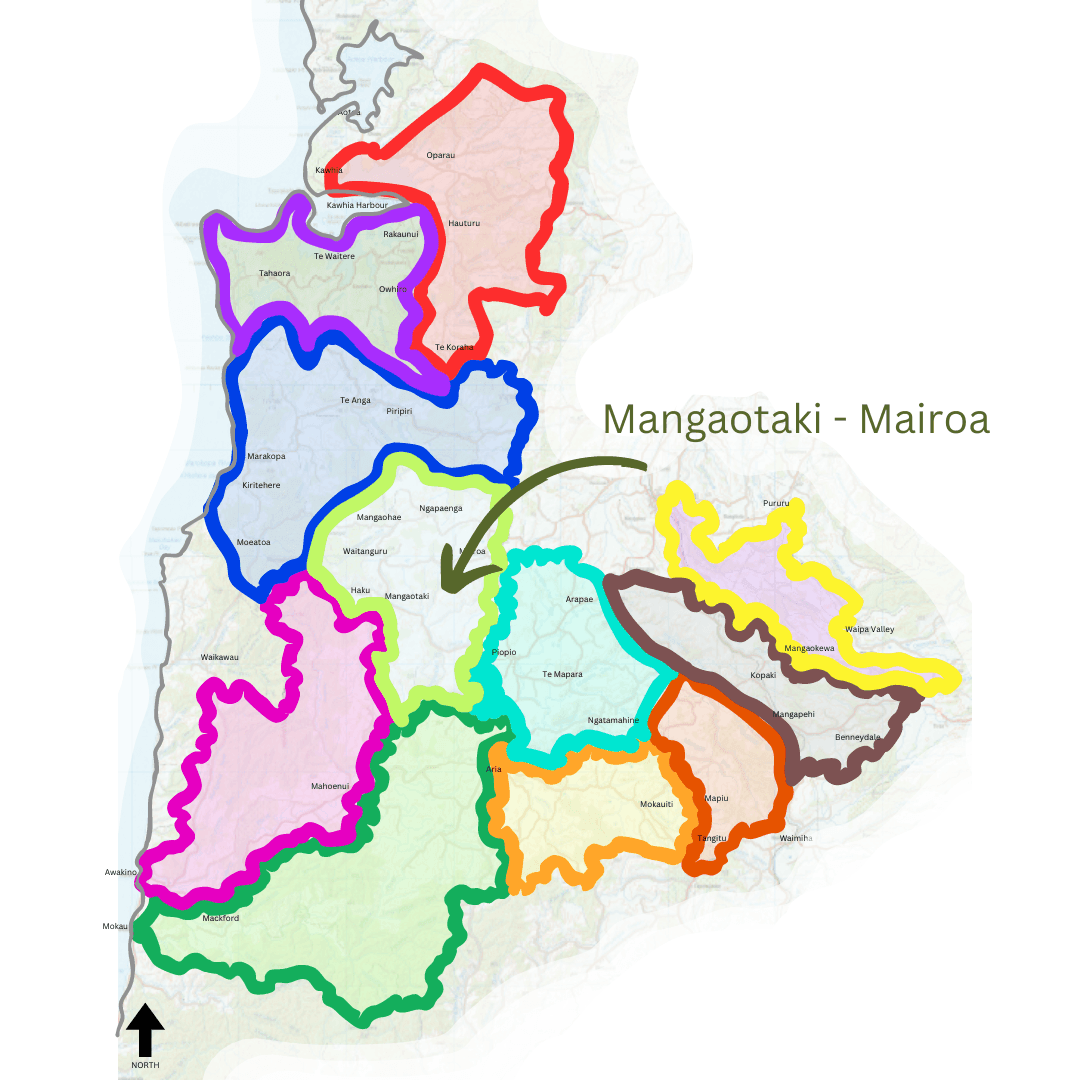
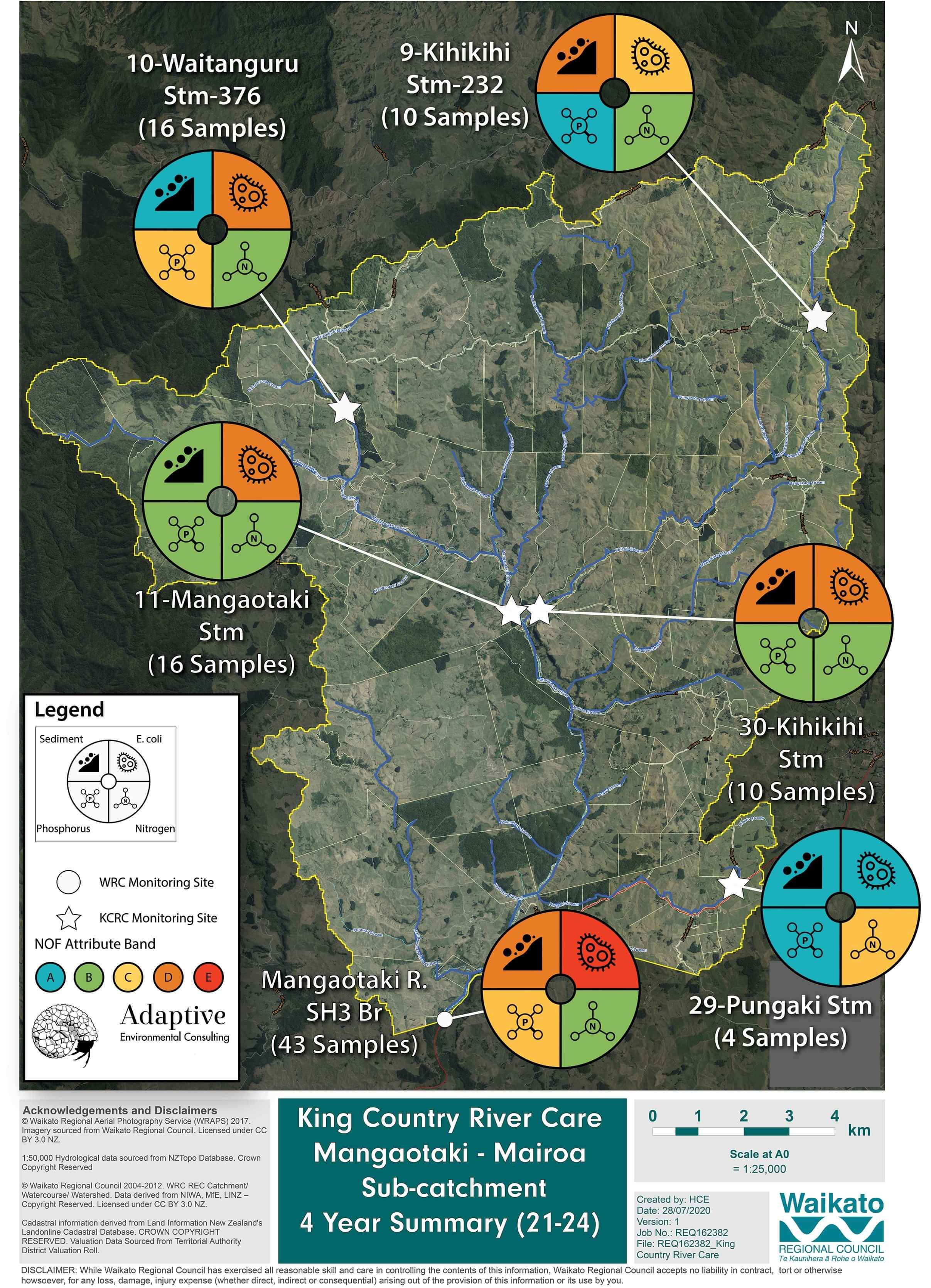
The 2024 results have been assessed against the national freshwater attribute bands under the national policy statement for freshwater (NPS-FM 2020).
The overall E. coli band is based on the following four measures, the percentage of samples exceeding 540 (CFU/100ml), the percentage of samples exceeding 260 (CFU/100ml), the median value and the 95th percentile (or upper 5% of E. coli concentrations).
The overall nitrogen band is based on the following six measures, Nitrate Toxicity (median and 95th percentile), Ammonia Toxicity (median and maximum annual value) and Dissolved Inorganic Nitrogen (median and 95th percentile).
The dials on the map below show water quality data from six monitoring sites in the Mangaotaki - Mairoa River sub-catchment. Each dial reflects all data collected at the site since the KCRC monitoring programme in 2021.
Catchment monitoring by King Country River Care, commenced in 2021. Across the entire Mokau River catchment the monitoring programme covers up to 16 monitoring sites across 6 sub-catchments sampled on a quarterly basis. Waikato Regional Council (WRC) has 5 monitoring sites in 4 of these 6 sub-catchments, which are monitored monthly. A water quality baseline was calculated from the time the catchment group was formed using five years (Jan 2015 – Dec 2019) of monthly monitoring data, collected at the WRC sites. The location of the monitoring sites for each sub-catchment are shown on Maps 1 through to 6, below.
2024 represents the fourth consecutive year of catchment monitoring. Water samples were collected on 14 Feb, 13 May, 22 August and 18 November, during stable weather to avoid any significant rainfall events. River flow strongly influences water quality and the river flow hydrograph for Mokau River at Totoro Road
Key Resources Being Lost from the Land
Monitoring across four sites in 2024 shows that the key resources lost from the Mangaotaki – Mairoa sub-catchment were E. coli and Sediment (reflected by low water clarity).
Loss of Sediment represents a loss of soil and nutrients.
Elevated E. coli represents a loss of organic matter and nutrients as it is largely associated with animal manure in rural catchments.
Catchment Hotspots
E. coli: Elevated at all sites - none met national health guidelines for swimming. Concentrations were highest at Mangaotaki River – SH3 Bridge and 11-Mangaotaki stream, and were lowest at Waitanguru stream.
Sediment: Suspended sediment was high at three out of four sites. The highest levels were at Kihikihi Stream and Mangaotaki River-SH3; the lowest levels were at Waitanguru Stream.
The below water quality dials summarise the results collected from the sites in the Mangaotaki – Mairoa sub-catchment and the Mokau River water quality Baseline. The dial at the top shows the baseline for Mokau River, covering 5 years of regional council monitoring at the five WRC monitoring sites (Awakau Road, Mokauiti Stream at 3-way Point Aria, Mangaotaki River-SH3 bridge, Totoro Road and Mangaokewa Road off SH30). The second dial combines all data collected at four sites in 2024, 24 samples in total. Arrows indicate either an increase or decrease in values compared to the sub-catchment baseline. An increase in water clarity is positive for river health while an increase in all other indicators may impair river health.
In 2024, nutrient indicators and water clarity/suspended sediment met national water quality limits, while E. coli did not. Compared to the baseline – Water clarity was higher and E. coli was lower. There was no difference in dissolved reactive phosphorus and nitrogen compared to baseline levels.
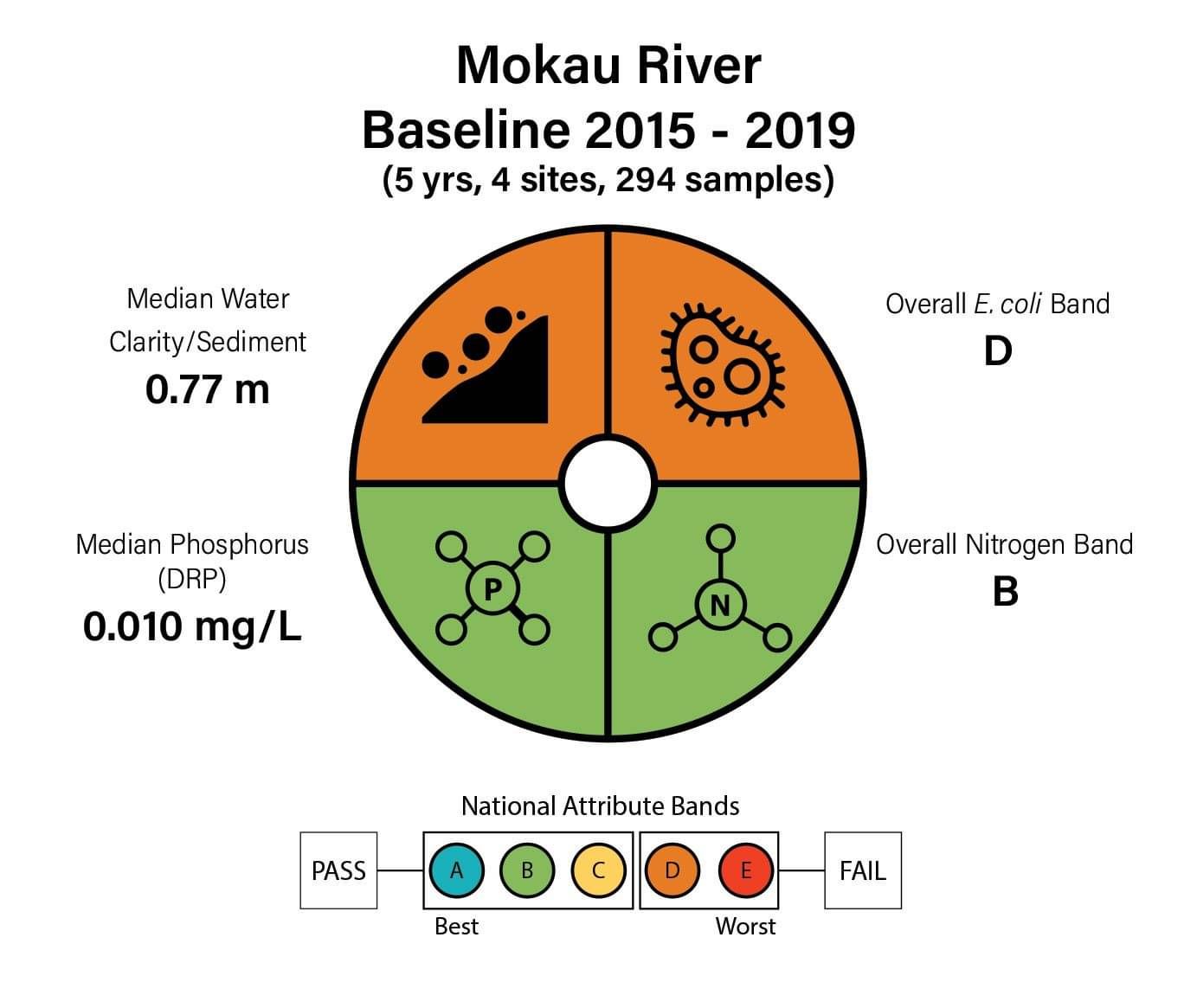
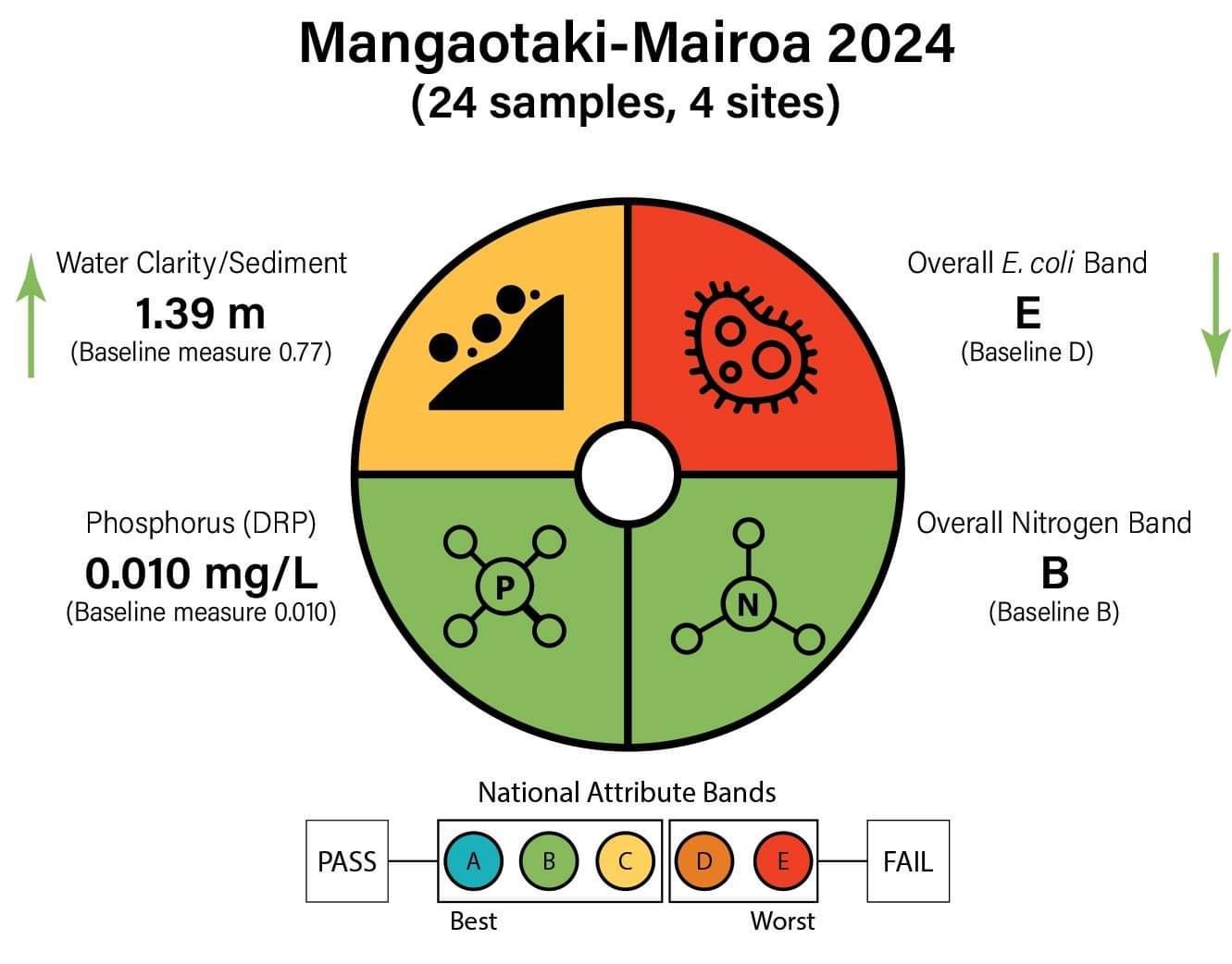
2024 Quarterly Results
November 2024
Water quality was Poor. E. coli, nutrients and suspended sediment were elevated across sites.
E. coli concentrations were elevated at all sites (between 610 to 1,000). All sites fell above the recommended health levels for swimming (540). E. coli concentrations were lowest at 10-Waitanguru stream and highest at 11-Mangaotaki river. Nitrate concentrations were below ecological toxicity levels (2.4 mg/L) at all sites. Nitrates were lowest at 11-Mangaotaki river (0.62 mg/L) and highest at 10-Waitanguru stream (0.80 mg/L). Ammonia concentrations were low at all sites (≤ 0.010 mg/L). However, dissolved inorganic nitrogen was elevated at all sites (between 0.63 and 0.81 mg/L). DIN concentrations above 0.5 mg/L can cause ecological problems, such as excessive growth of algae and aquatic plants, and loss of sensitive aquatic species. Dissolved reactive phosphorus was low at 30-Kihikihi stream (0.009) but were very high in 10-Waitanguru stream (0.065 mg/L) and 11-Mangaotaki river (0.019 mg/L), suggesting a direct input of phosphorus to waterways upstream of these two sites. Water clarity was poor at all sites (between 0.83 and 1.36 m), relative to the national bottom line (1.34 m).
Sample Collection Date 19th November 2024

Mokau River – Summary of water quality collected at 15 sites across the Mokau River catchment on 19th November 2024
E. coli and suspended sediment were elevated across most sites and a third of all sites had elevated concentrations of dissolved inorganic nitrogen. While dissolved reactive phosphorus (DRP) was generally low, very high DRP concentrations were recorded at several locations.
E. coli: 73% of sites had elevated concentrations (between 610 and 1,500), 20% (3 sites) had slightly elevated concentrations (between 370 and 470), while only 7% (1 site) had a low concentration (≤ 110). Nitrate and Ammonia: 100% of sites were well below toxicity levels. Nitrate range (0.13 – 0.80 mg/L); Ammonia range (<0.005 - 0.05). Dissolved inorganic nitrogen (DIN): 67% of sites had low concentrations (≤ 0.46 mg/L) and 33% were slightly elevating, falling above the ecological impact threshold of 0.5 mg/L (between 0.54 and 0.81 mg/L). The highest DIN concentration recorded across the Mokau River catchment was 0.81 mg/L. Dissolved reactive phosphorus: 73% of sites had low concentrations (between <0.002 to 0.010 mg/L), 7% (1 site) was slightly elevated (0.017 mg/L) and 20% (3 sites) had very high concentrations (between 0.019 and 0.065 mg/L). Water clarity: 13% (2 sites) had good water clarity (A or B band), 13% (2 sites) had reduced water clarity (C band) and the remaining 73% had poor water clarity (D band). Bands for each site relate to the national bottom line (NBL) for water clarity and are dependent on landscape characteristics including geology, climate and elevation. The NBL for Mokau River’s monitoring sites are either 1.34 m or 0.61 m, dependant on the local landscape characteristics.
August 2024
Water quality was Fair. E. coli, dissolved inorganic nitrogen, dissolved reactive phosphorus and suspended sediment were elevated across sites.
E. coli concentrations were low at two sites (≤ 210) and were slightly elevated at 11-Mangaotaki River (410). All sites were well within recommended health levels for swimming (540). Nitrate concentrations were well below ecological toxicity levels (2.4 mg/L) at all sites. Nitrates were lowest at 11-Mangaotaki River (0.70 mg/L) and highest at 30-Kihikihi stream (0.92 mg/L). Ammonia concentrations were very low at all sites (≤ 0.007 mg/L). However, dissolved inorganic nitrogen was slightly elevated at all sites, above levels which can cause ecological impacts (> 0.5 mg/L) like excessive growth of algae and aquatic plants, and loss of sensitive aquatic species. Dissolved reactive phosphorus concentrations were low at two sites (0.009) and slightly elevated at 10-Waitanguru stream (0.012 mg/L). Water clarity was good at 10-Waitanguru stream (1.6 m) and poor at the other two sites, relative to the national bottom line (1.34 m).
Sample Collection Day: 13th August 2024

Mokau River – Summary of water quality collected at 15 sites across the Mokau River catchment on 13th August 2024
E. coli, ammonia and dissolved reactive phosphorus were low at most sites. The key contaminants were suspended sediment and nitrate.
E. coli: 73% of all sites had low concentrations (≤210), while 27% (4 sites) had slightly elevated concentrations (between 310 to 410). Nitrate and Ammonia: 100% of sites were well below toxicity levels. Nitrate range (0.2 – 0.92 mg/L); Ammonia range (<0.005 - 0.03). Dissolved inorganic nitrogen (DIN): 53% of sites had low concentrations (≤0.47 mg/L) and 47% fell above the ecological impact threshold of 0.5 mg/L. The highest DIN concentration was 0.93 mg/L. Dissolved reactive phosphorus: 93% of sites had low concentrations (between <0.002 to 0.009 mg/L), 7% (1 site) had slightly elevated concentrations 0.012 mg/L. Water clarity: 27% (4 sites) had good water clarity (A or B band), 7% (1 site) had reduced water clarity (C band) and the remaining 67% had poor water clarity (D band). Bands for each site relate to the national bottom line (NBL) for water clarity and are dependent on landscape characteristics including geology, climate and elevation. The NBL for Mokau River’s monitoring sites are either 1.34 m or 0.61 m, dependant on the local landscape characteristics.
May 2024
Overall, water quality was Good, except for dissolved inorganic nitrogen which was elevated at all sites.
E. coli concentrations were low at all sites (≤ 240) and well within recommended health levels for swimming (540). Nitrate concentrations were well below ecological toxicity levels (2.4 mg/L) at all sites. Nitrates were lowest at 11-Mangaotaki River (0.62 mg/L) and highest at 10-Waitanguru stream (0.79 mg/L). Ammonia concentrations were very low at all sites (< 0.005 mg/L). However, dissolved inorganic nitrogen was slightly elevated at all sites, above levels which can cause ecological impacts (> 0.5 mg/L) like excessive growth of algae and aquatic plants, and loss of sensitive aquatic species. Dissolved reactive phosphorus concentrations were low at all sites (≤ 0.008). Water clarity was excellent at two sites (≥ 2.20 m) and good at 30-Kihikihi Stream (1.56 m), relative to the national bottom line (1.34 m).
Collection date: 14th May 2024

Mokau River – Summary of water quality collected at 15 sites across the Mokau River catchment May 2024
E. coli and Nutrients (nitrate, ammonia and dissolved reactive phosphorus) were low at most sites. The key contaminant was suspended sediment.
E. coli: 93% of all sites had low concentrations (≤240) and 7% (1 site) had elevated concentrations (510). Nitrate and Ammonia: 100% of sites were well below toxicity levels. Nitrate range (0.15 – 0.79 mg/L); Ammonia range (<0.005 - 0.02). Dissolved inorganic nitrogen: 73% of sites had low concentrations (≤0.44 mg/L) and 27% (4 sites) fell above the ecological impact threshold of 0.5 mg/L with the highest concentration being 0.79 mg/L. Dissolved reactive phosphorus: 100% of sites had low concentrations (between <0.002 - 0.008 mg/L). Water clarity: 60% of sites had good water clarity (A or B band), 20% (3 sites) had reduced water clarity (C band) and the remaining 20% had poor water clarity (D band). Bands for each site relate to the national bottom line (NBL) for water clarity and are dependent on landscape characteristics including geology, climate and elevation. The NBL for Mokau River’s monitoring sites are either 1.34 m or 0.61 m, dependant the local landscape characteristics.
February 2024
Overall, water quality was Fair with E. coli, dissolved inorganic nitrogen and water clarity being slightly impacted.
E. coli concentrations were low at 10-Waitanguru stream (200) and slightly elevated at 11-Mangaotaki River and 30-Kihikihi stream. All sites fell within recommended health limit for swimming (540). Nitrate concentrations were well below ecological toxicity levels (2.4 mg/L) at all sites. Nitrates were lowest at 11-Mangaotaki River (0.39 mg/L) and highest at 30-Kihikihi stream (0.53 mg/L). Ammonia concentrations were very low at all sites (< 0.007 mg/L). Dissolved inorganic nitrogen was low at 11-Mangaotaki River (0.4 mg/L) and slightly elevated at 10-Waitanguru Stream and 30-Kihikihi stream (> 0.5 mg/L), at levels which can cause impacts like excessive growth of algae and aquatic plants, and loss of sensitive aquatic species. Dissolved reactive phosphorus concentrations were low at all sites (≤ 0.009). Water clarity was excellent at two sites (≥ 2.45 m) and slightly low at 30-Kihikihi Stream (1.42 m), relative to the national bottom line (1.34 m).
Collection date: 28th February 2024

Mokau River –Summary of water quality collected at 15 sites across the Mokau River catchment February 2024
Nutrient concentrations (nitrate, ammonia and dissolved reactive phosphorus) were low at most sites. Key contaminants were E. coli and suspended sediment.
E. coli: 60% of all sites had low concentrations (≤260) and 40% had slightly elevated concentrations (between 300 - 450). Nitrate and Ammonia: 100% of sites were well below toxicity levels. Nitrate range (0.04 – 0.53 mg/L); Ammonia range (<0.005 - 0.03). Dissolved inorganic nitrogen: 87% of sites had low concentrations (≤0.4 mg/L) and 13% (2 sites) fell above the ecological impact threshold of 0.5 mg/L with the highest concentration being 0.54 mg/L. Dissolved reactive phosphorus: 100% of sites had low concentrations (between <0.002 - 0.01 mg/L). Water clarity: 53% of sites had good water clarity (A or B band), 13% (2 sites) had reduced water clarity (C band) and 33% of sites had poor water clarity (D band). Bands for each site relate to the national bottom line (NBL)
Water Quality Summary 2023
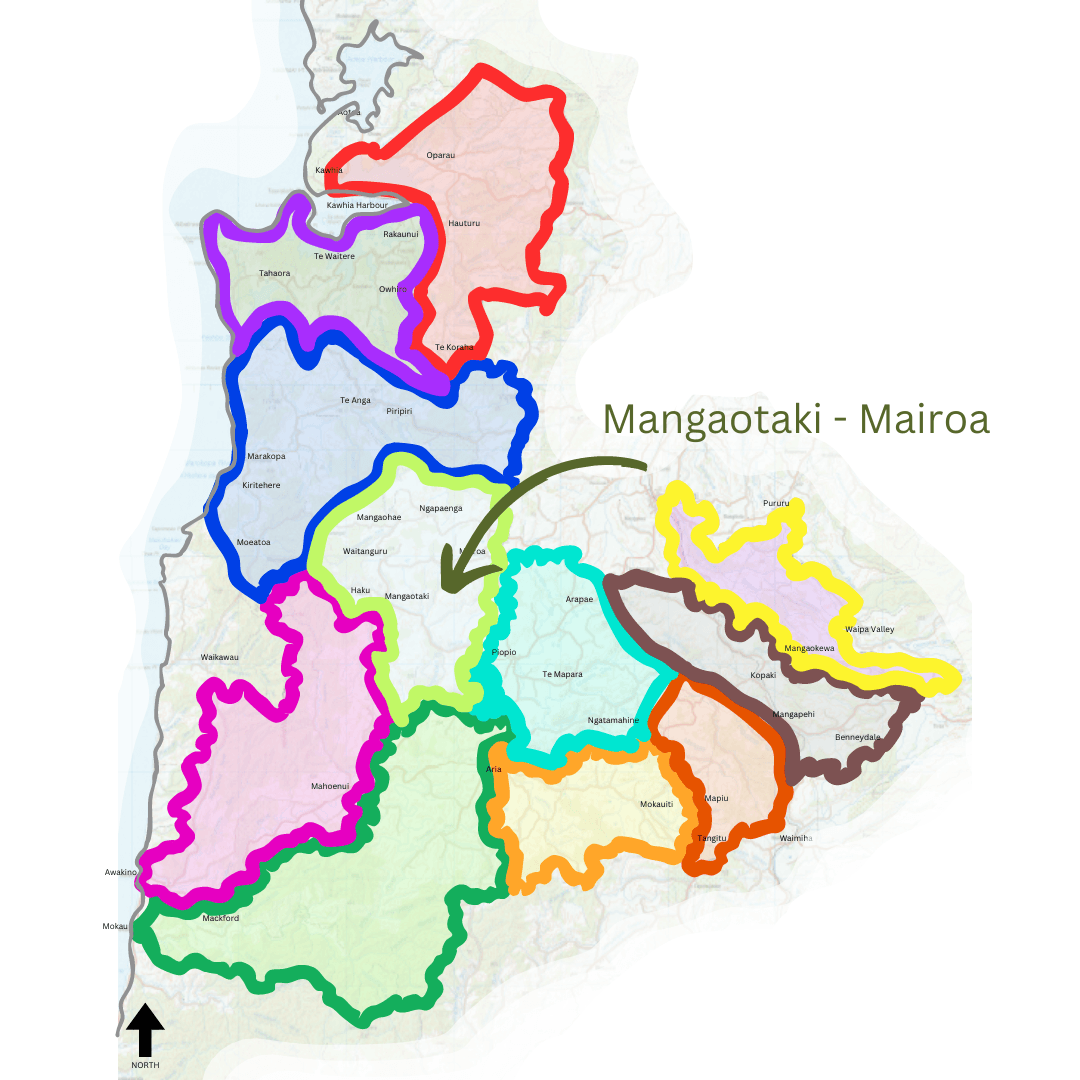
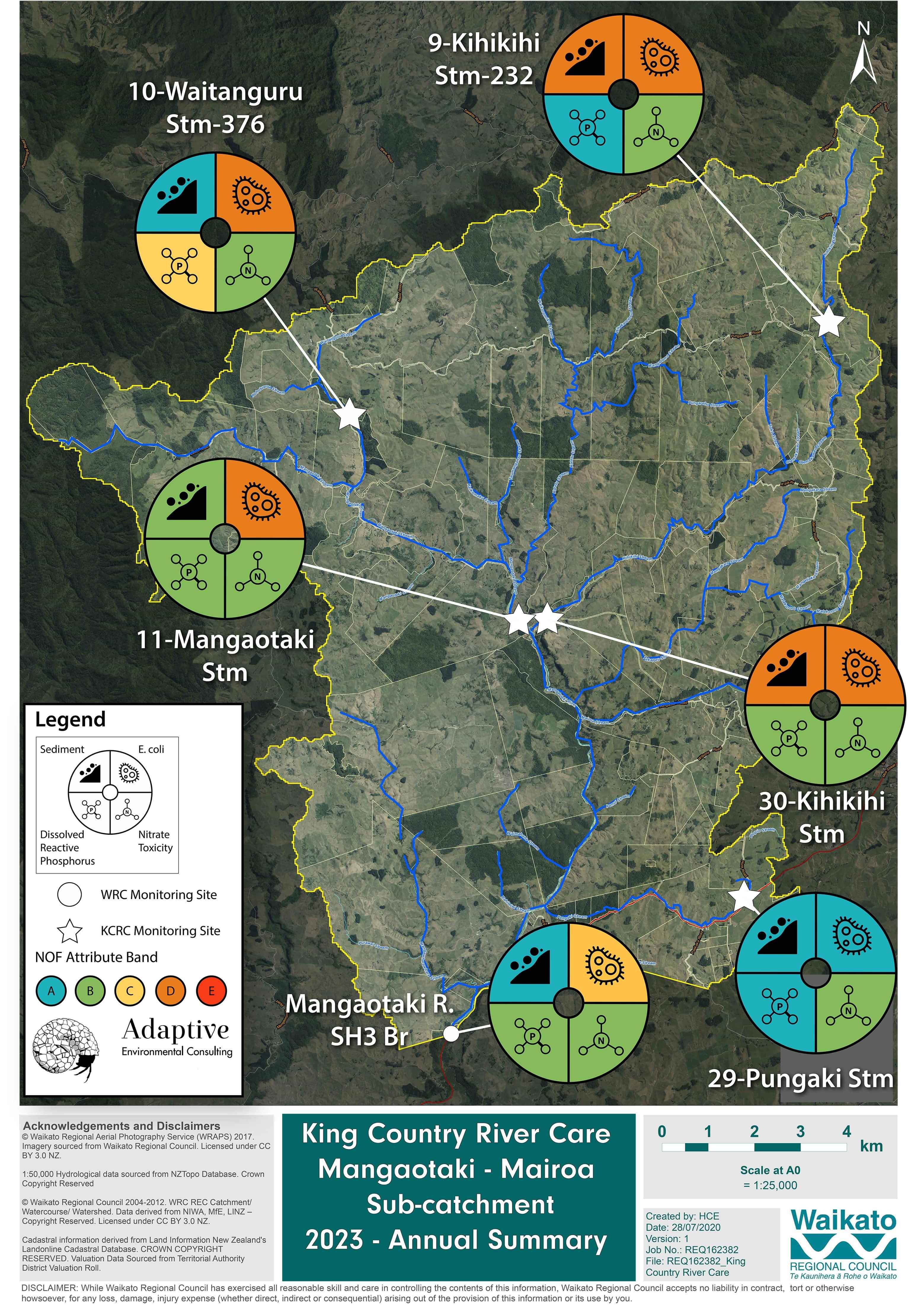
Water samples were collected from 6 stream and river sites across the Mangaotaki-Mairoa catchment. Monitoring sites were located on Kihikihi stream, Waitanguru stream, Pungaki stream and the Mangaotaki River. The below water quality dial summarises 25 individual samples collected across 6 sites, between January 2023 and December 2023.
Water clarity was low, indicated elevated levels of suspended sediment, which may impact aquatic life. E. coli was slightly elevated which can pose a slight risk to human health when swimming. Nitrogen and dissolved reactive phosphorus (DRP) were low, which supports river health. All attributes met national water quality standards.
Arrows indicate an increase or decrease in values compared to the baseline. The baseline was calculated from 5 years of data collected by Waikato Regional Council at 5 sites, between 2015 and 2019. An increase in water clarity is positive for river health, while an increase in all other attributes may impair river health.
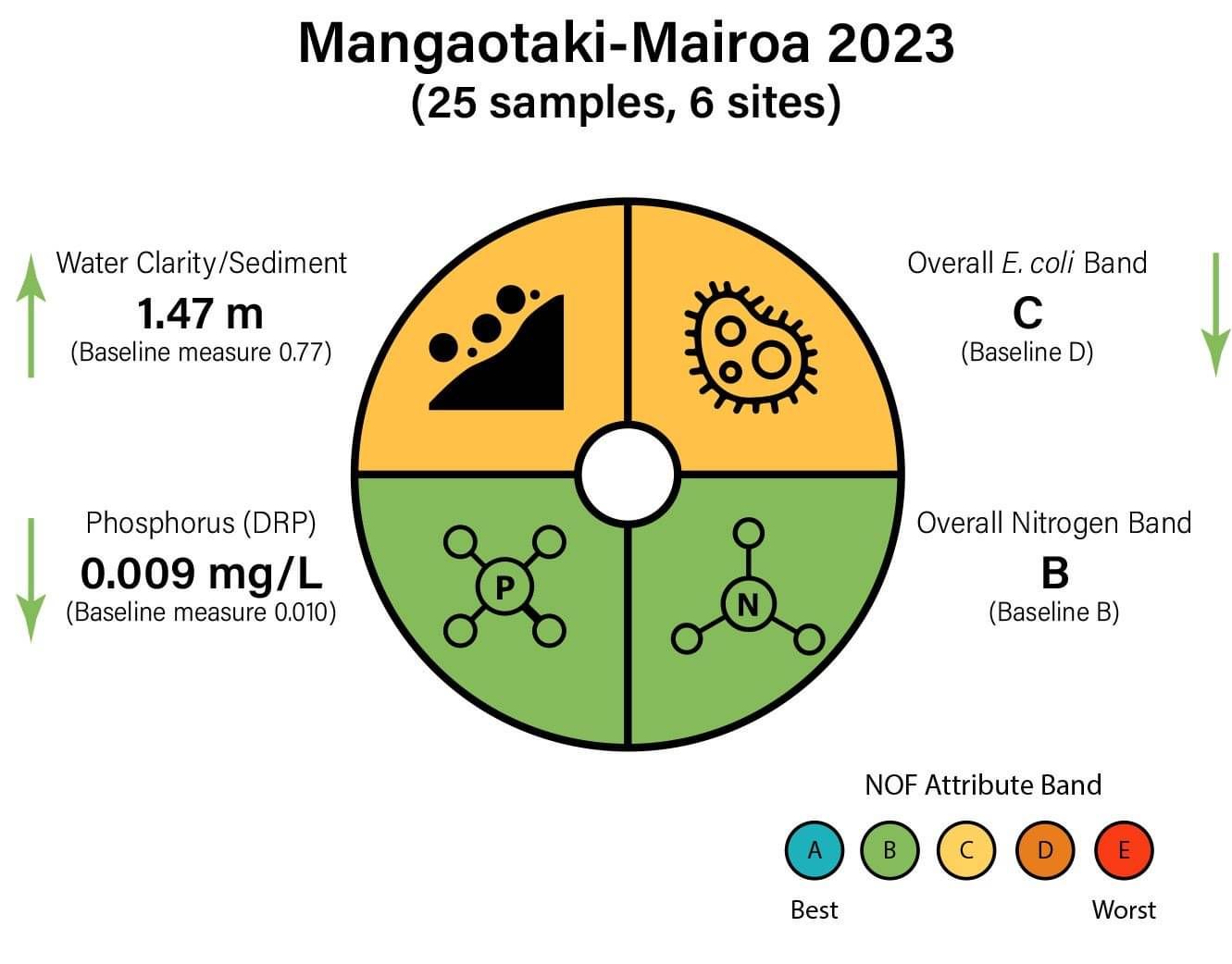
Aquatic Biodiversity Summary
Biodiversity monitoring includes eDNA, collected by KCRC, and traditional biodiversity monitoring techniques (netting of freshwater invertebrates and netting and electrofishing of freshwater fish), by Waikato Regional Council (WRC). eDNA sampling has been done by KCRC, in autumn and winter in 2021, 2022 and 2023. WRC monitors most sites every 1 to 2 years, between November and March. If more than one results is available for any single monitoring location the results for that site are averaged across years.
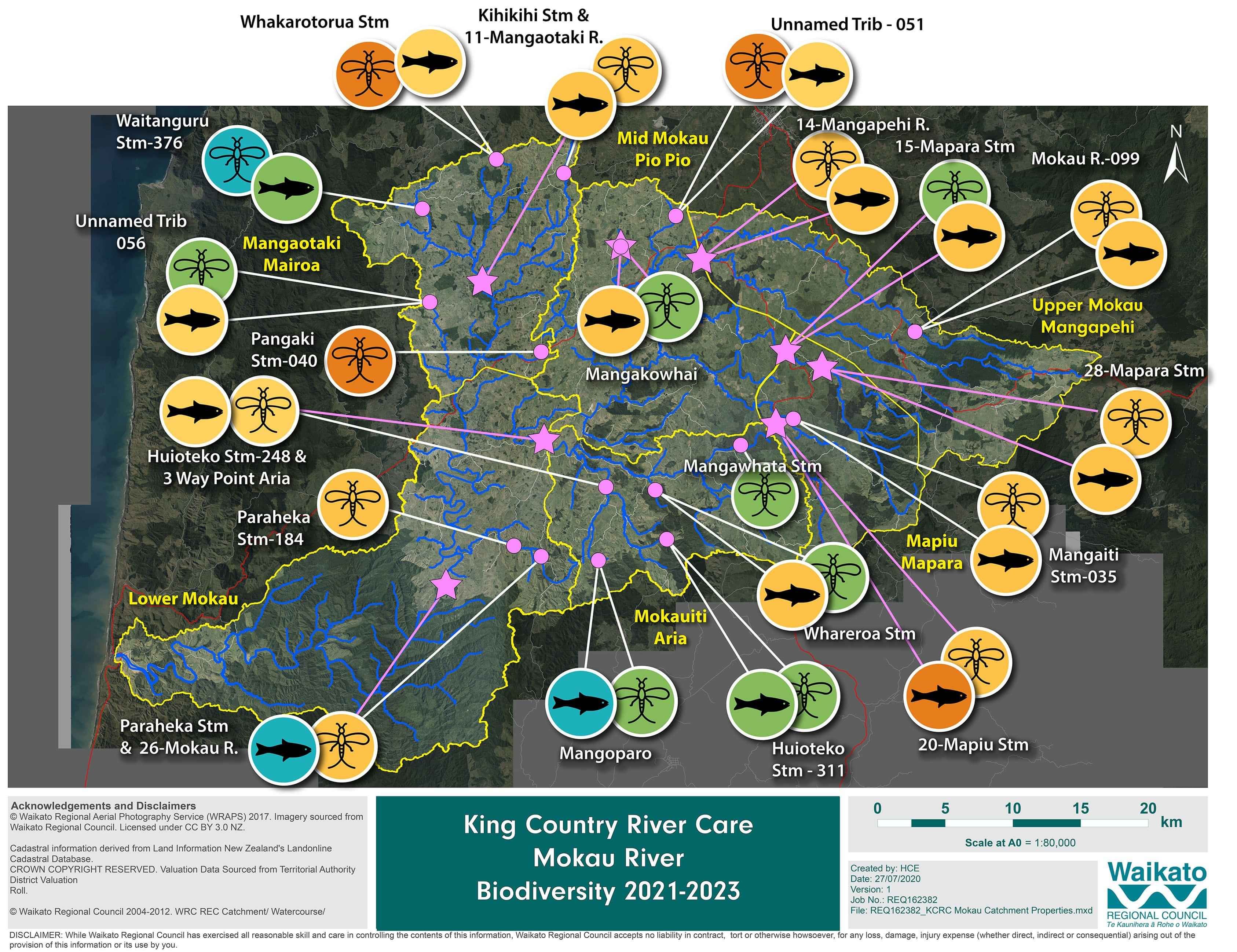
Mōkau River has signs of ecological stress.
Freshwater invertebrate MCI scores indicate ecological stress at some sites in all sub-catchments expect for Mokauiti-Aria, where nearly all sites had good MCI scores and two out of three sites had good fish scores. Mangaotaki-Mairoa also had two sites with good invertebrate scores.
The number of insect species detected from eDNA (an indicator for ecological health) were low to moderate, ranging between 20 to 40 species across the 7 sub-catchments. Mapiu stream, Mapara stream, Mangaotaki and Mokauiti streams had the highest number of insect species, while Mangaokowhai stream and the Upper Mōkau had the lowest number of insect species detected.
Native freshwater mussels, a rare invertebrate species and filter feeder, were detected in the sub-catchments of upper Mōkau, Mokauiti-Aria and the lower Mōkau.
The Mōkau river has a diverse fish community in the lower reaches (14 species), however, fish diversity is very low in the mid and upper reaches, consisting mainly of eels (longfin and shortfin) and brown trout.
Only one whitebait species was detected, Īnanga, in the lower reaches only.
Threatened fish species detected in the catchment include, lamprey, Īnanga, redfin bully, longfin eel and torrentfish.
Four species of introduced fish detected, mosquito fish, goldfish, brown trout and rainbow trout.
Barriers to fish migration in the Mōkau river, including manmade structures like dams and perched culverts and natural features like high waterfalls, will be restricting fish diversity.
The Mōkau River has at least two large manmade barriers to fish migration, the Mokauiti Dam and the Wairere Dam, and at least on large natural barrier, Omaru falls (45m high).
Many of our native species are excellent climbers, elvers can scale waterfalls up to 40 m high and kōaro even higher than this.
Mokau Sub Catchment Areas
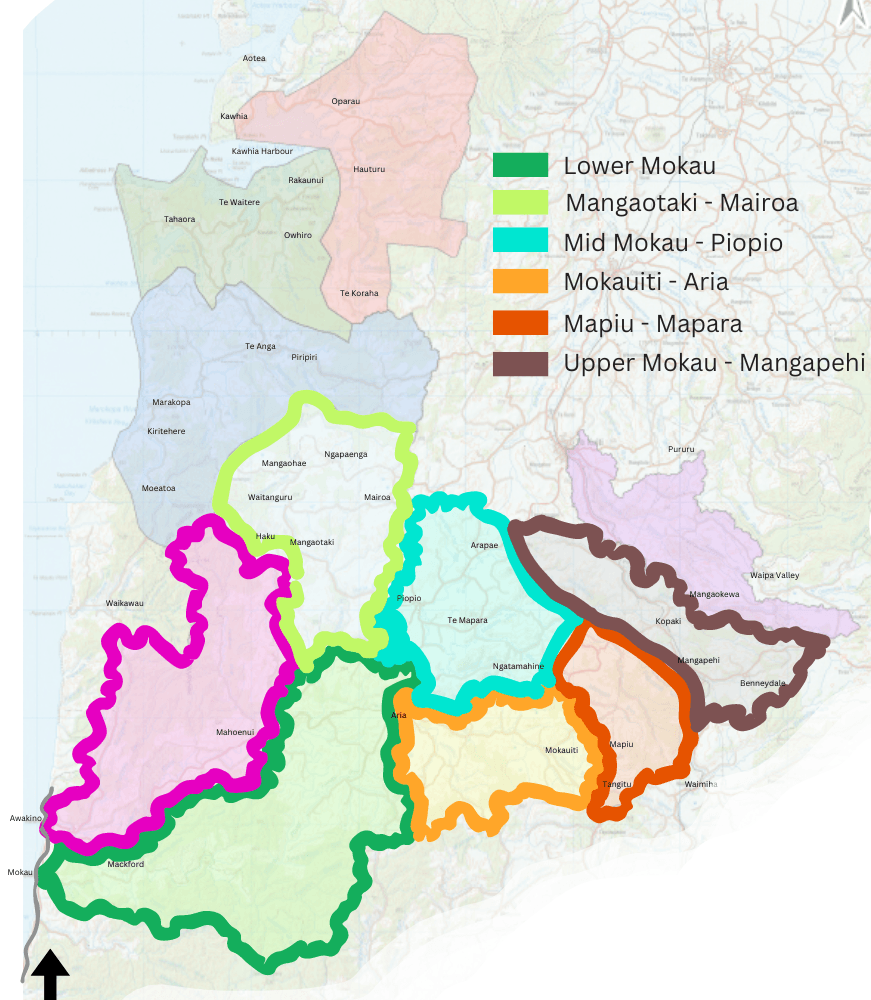
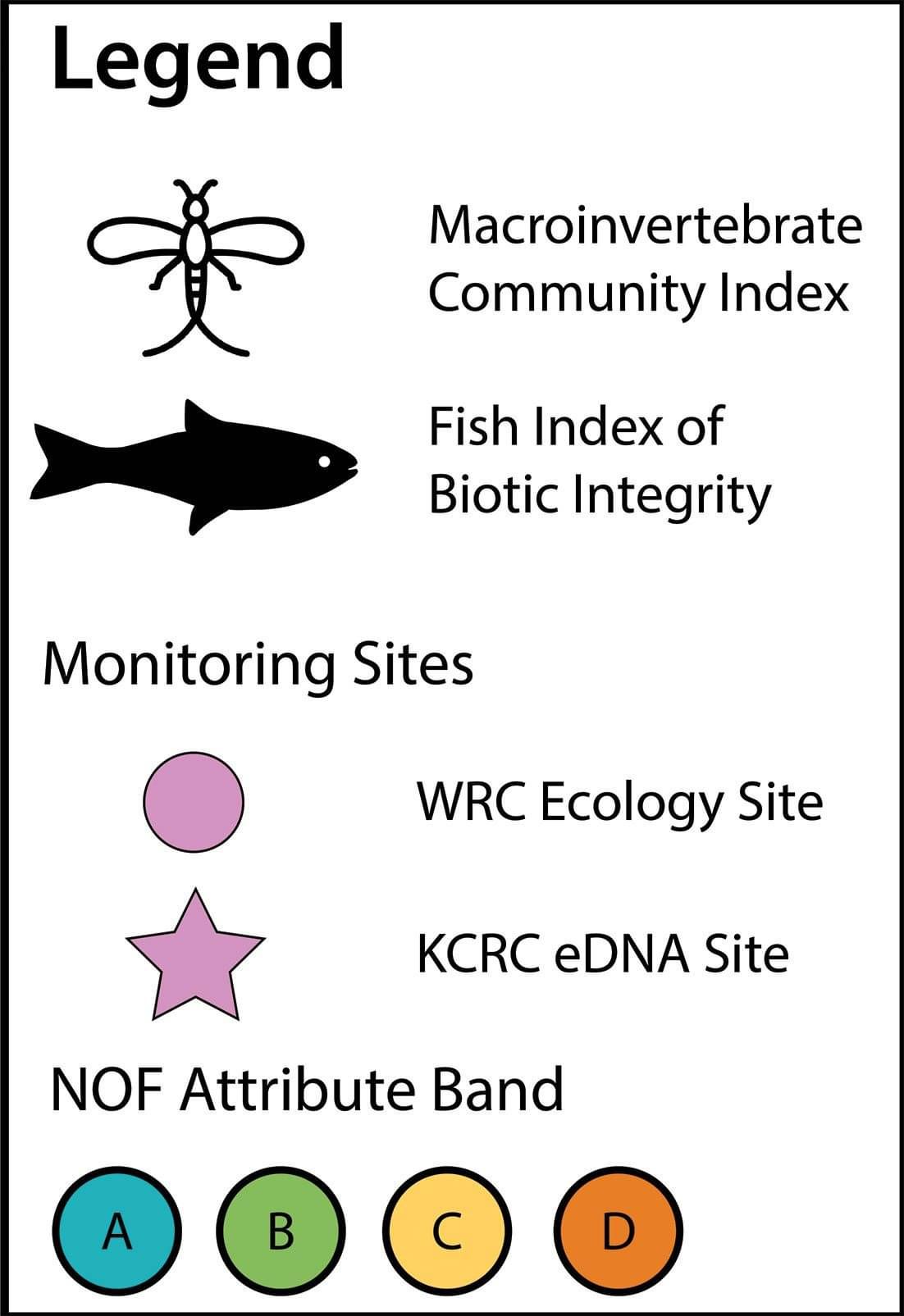
2023 Quarterly Results
November 2023
Overall, water quality at Mokau River, above the Wairere Dam was good on 13th November 2023.
E. coli was low (190). Nitrate and Ammonia concentrations were well below toxicity levels (Nitrate 0.37 mg/L; Ammonia 0.02 mg/L). Dissolved inorganic nitrogen was low (0.39 mg/L). Dissolved reactive phosphorus was exceptionally low (0.006 mg/L). Water clarity was poor (1.03 m) relative to the national bottom line (1.34 m).
Collection date: 13 November 2023

Mokau River – All sites in sub-catchment (November 2023)
Nutrient concentrations (nitrate, ammonia and dissolved reactive phosphorus) were low at most sites. Key contaminants were E. coli and water clarity.
E. coli: 56% of all sites had low concentrations (≤230), 25% had slightly elevated concentrations (between 280 - 530) and 19% had elevated concentrations (> 730). Nitrate and Ammonia: concentrations at 100% of sites were below toxicity levels (Nitrate ≤ 0.62 mg/L; Ammonia ≤ 0.02). Only one site had Dissolved Inorganic Nitrogen (DIN) concentrations above 0.5 mg/L. Ecological impacts, including problematic growth of algae and/or aquatic plants and loss of sensitive aquatic species are likely to occur when DIN regularly exceeds 0.5 mg/L. Dissolved reactive phosphorus: 94% of sites had low concentrations (≤ 0.009 mg/L) and one site (16%) had slightly elevated concentrations (0.011 mg/L).Water clarity: 44% of sites had good water clarity (A or B band), two sites (13%) had reduced water clarity (C band) and 44% of sites had poor water clarity (D band). Bands for each site relate to the national bottom line (NBL) for water clarity and are dependent on landscape characteristics including geology, climate and elevation. The NBL for Mokau River’s monitoring sites are either 1.34 m or 0.61 m, dependant the local landscape characteristics.
September 2023
Overall, water quality at Mokau River, above the Wairere Dam was fairly good on 13th September. E. coli and dissolved reactive phosphorus were low, while the concentration of suspended sediment was elevated and Dissolved Inorganic Nitrogen was slightly elevated. E. coli was low (160). Nitrate and ammonia concentrations were well below toxicity levels (Nitrate 0.59 mg/L; Ammonia 0.02 mg/L). Dissolved inorganic nitrogen was 0.61 mg/L, potentially impacting the health of the river. Dissolved reactive phosphorus concentrations was exceptionally low (0.005 mg/L). Water clarity was poor (0.83 m), relative to the national bottom line (1.34 m).
Collection date: 13 September 2023

Mokau River – All sites in all sub-catchments (September 2023)
Summary of water quality collected at 16 sites located across the Mokau River catchment sampled on 12th or 13th of September. E. coli: 63% of all sites had low concentrations (≤220), 25% had slightly elevated concentrations (between 270 - 380) and 13% of sites had elevated concentrations (> 550). Nitrate and Ammonia: 100% of sites had concentrations below toxicity levels (Nitrate ≤ 0.79 mg/L; Ammonia ≤ 0.09). However, 50% of sites had Dissolved Inorganic Nitrogen (DIN) concentrations over 0.5 mg/L. Ecological impacts, including problematic growth of algae and/or aquatic plants and loss of sensitive aquatic species are likely when the combined concentration of DIN regularly exceed 0.5 mg/L. Dissolved reactive phosphorus: 94% of sites had low concentrations (≤ 0.009 mg/L) and one site (16%) had an elevated concentration (0.011 mg/L). Water clarity: 56% of sites had good water clarity (A or B band) and 44% of sites had poor clarity (D band). Bands for each site relate to the national bottom line for water clarity, which is either 1.34 m or 0.61 m, and is dependent on the local geology, climate and elevation.
May 2023
E. coli concentrations were low at all sites (≤ 230). Nitrate concentrations were below toxicity levels at all sites, being lowest at 29-Pungaki Stream (0.83 mg/L) and highest at 30-Kihikihi Stream (1.09 mg/L). Ammonia concentrations were exceptionally low at all sites (< 0.005 mg/L). All sites had dissolved inorganic nitrogen concentrations exceeding 0.5 mg/L, potentially impacting the health of the river. Dissolved reactive phosphorus concentrations were low at 9- Kihikihi Stream and 29-Pungaki Stream (≤ 0.006 mg/L) and elevated at all other sites (≥ 0.011 mg/L). Water clarity was excellent at 29-Pungaki Stream (3.24 m) and poor at all other sites (≤ 1.39 m), relative to the national bottom line (1.34 m).
Sample date 14 May 2023.

Mokau River – All sites in all sub-catchments
This summarises the results collected across the Mokau River catchment from 27 sites sampled on either the 8th or 14th of May: E. coli: 58% of all sites had low concentrations (≤260) and 42% had slightly elevated concentrations (between 270 - 360). Nitrate and Ammonia: 100% of sites had concentrations below toxicity levels (Nitrate ≤ 2.39 mg/L; Ammonia ≤ 0.04). However, 67% of sites had Dissolved Inorganic Nitrogen (DIN) concentrations over 0.5 mg/L. Ecological impacts, including problematic growth of algae and/or aquatic plants and loss of sensitive aquatic species are likely when the combined concentration of DIN regularly exceed 0.5 mg/L. Dissolved reactive phosphorus: 83% of sites had low concentrations (≤ 0.009 mg/L) and 17% of sites had elevated concentrations (0.011 – 0.017 mg/L). Water clarity: 8% of sites had good water clarity (A or B band), 8% had moderate clarity (C band) and 83% of sites had poor clarity (D band). Bands for each site relate to the national bottom line for water clarity, which is either 1.34 m or 0.61 m, and is dependent on the local geology, climate and elevation.
February 2023
Water Quality Summary 2022
The water quality dial for Mangaotaki-Mairoa combines data collected at 6 monitoring sites between January – December 2022, representing 28 individual samples. Nitrates and dissolved reactive phosphorus (DRP) were low. E. coli was elevated, while water clarity was low indicating elevated sediment loading. Arrows indicate an increase or decrease in values compared to the sub-catchment baseline (2015 – 2020). An increase in water clarity is positive for river health while an increase in all other attributes may impair river health.
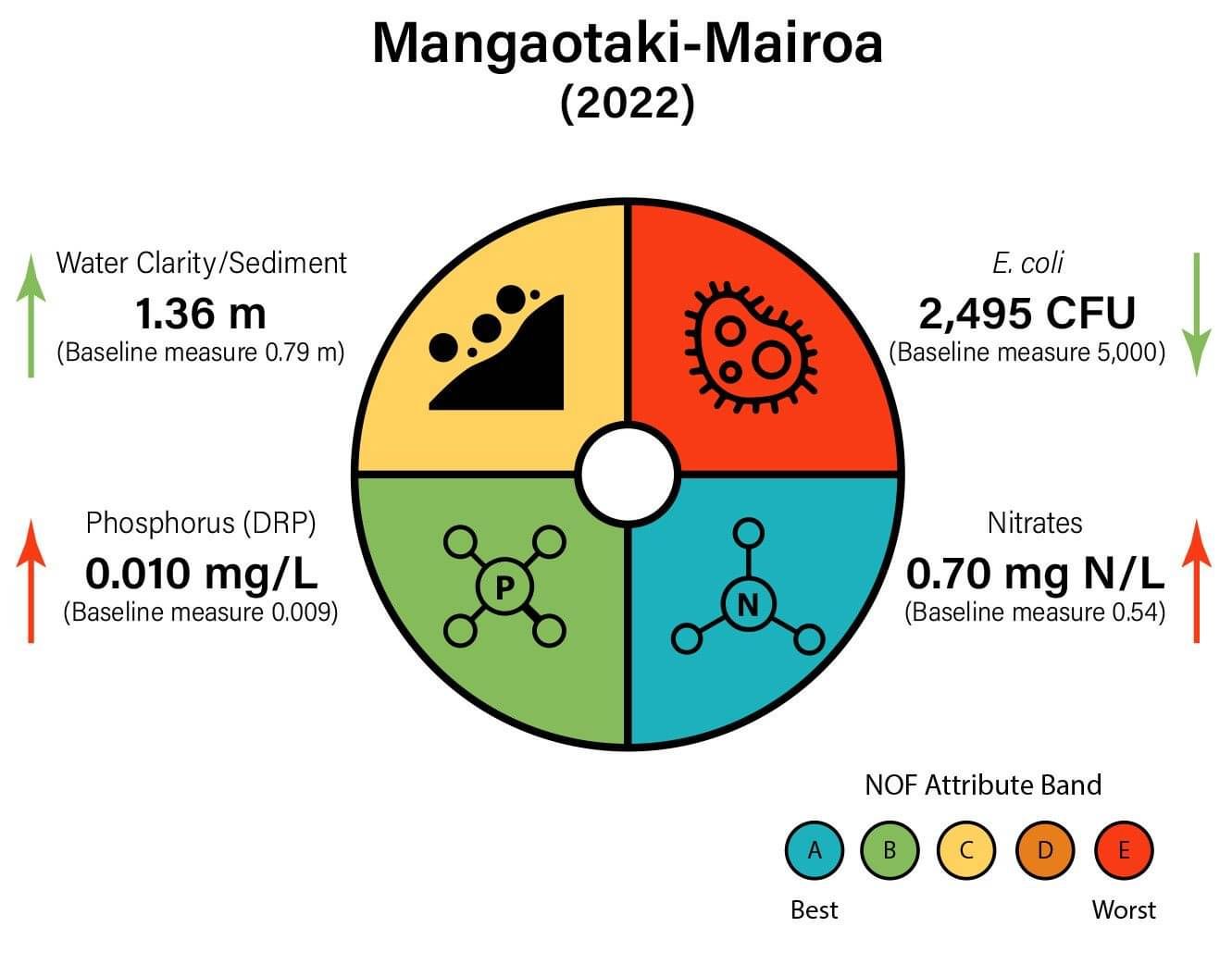
2021 Summary
E. coli, is the main contaminants of concern.
Sediment and DRP were elevated at 10-Waitanguru stream. Sediment was elevated at Mangaotaki River, the WRC site.
Site 9-Kihikihi stream had the best water quality and Mangaotaki River had the lowest water quality in 2021.
Attribute bands
A (or blue is the best) through to E (red) which is the worst.
